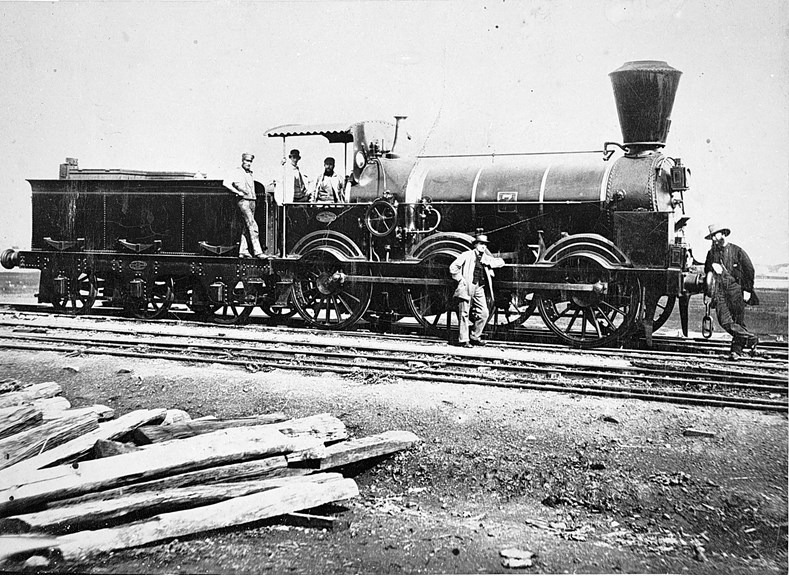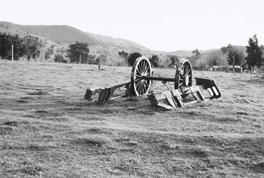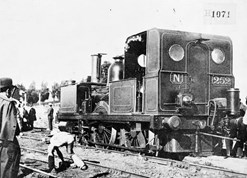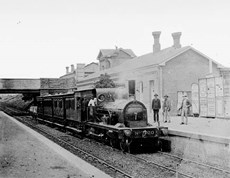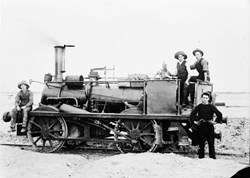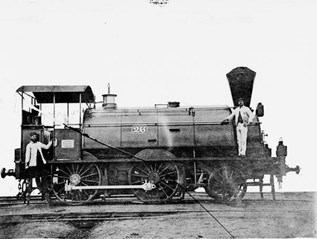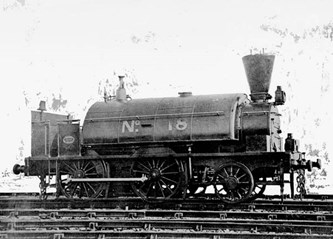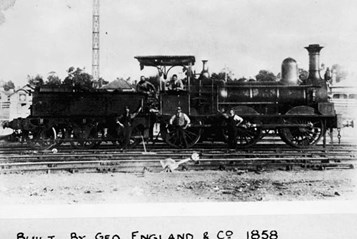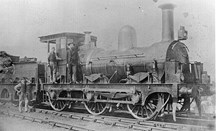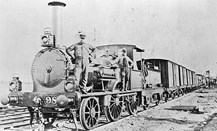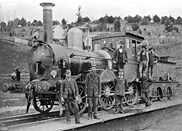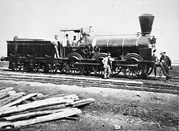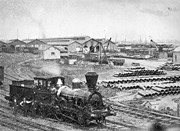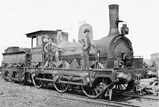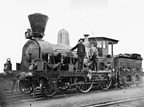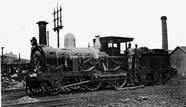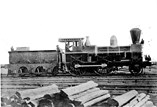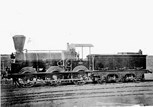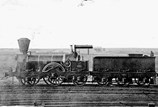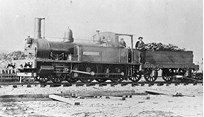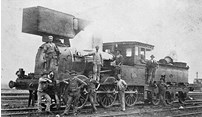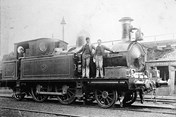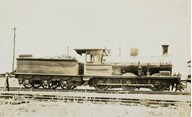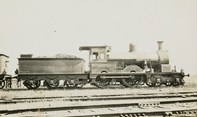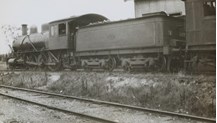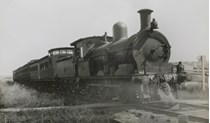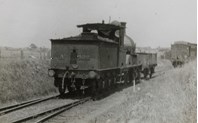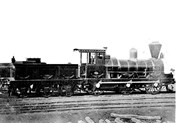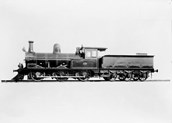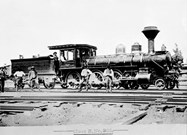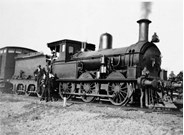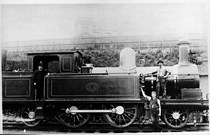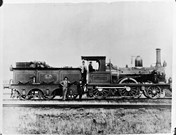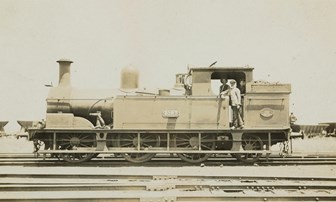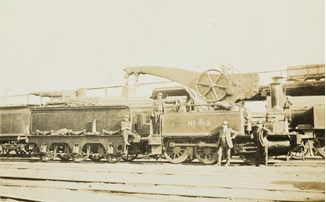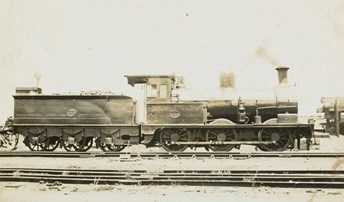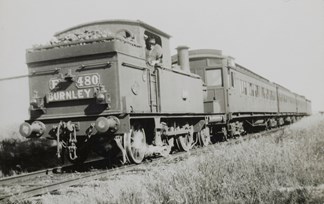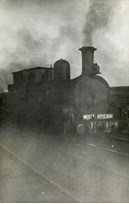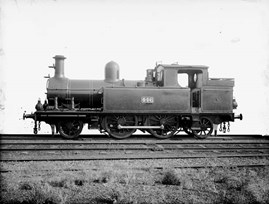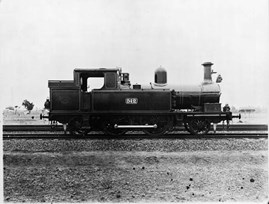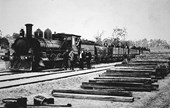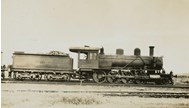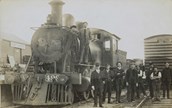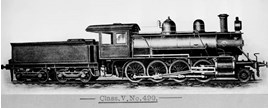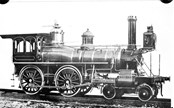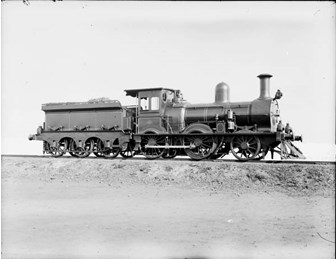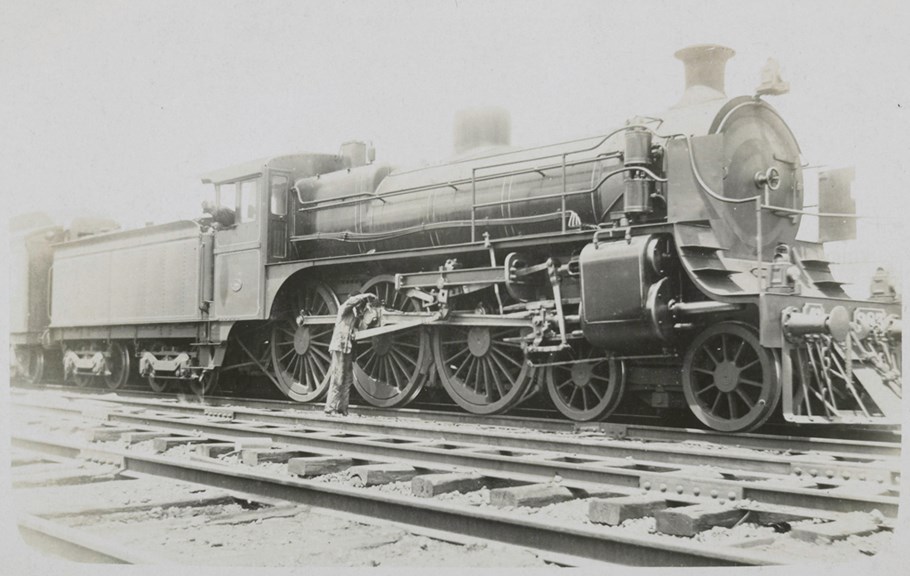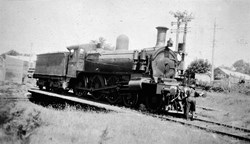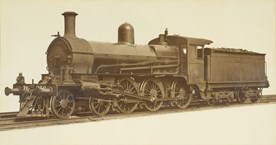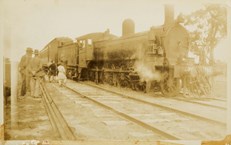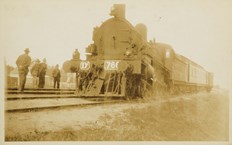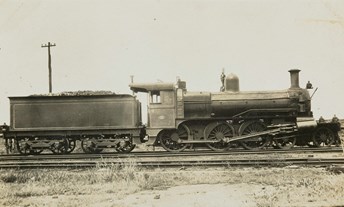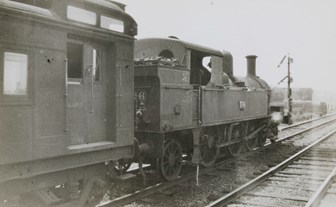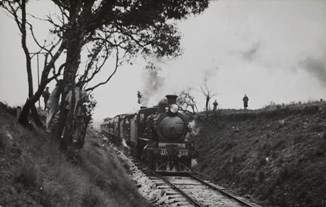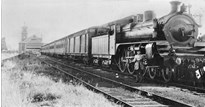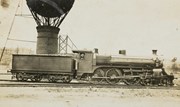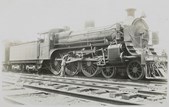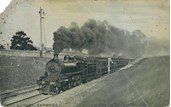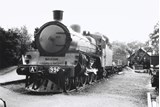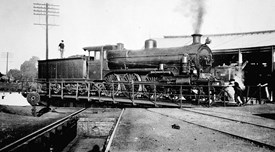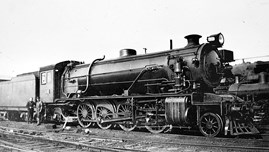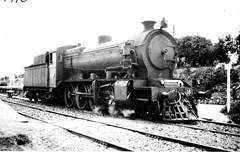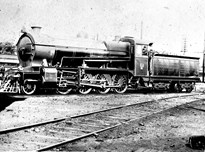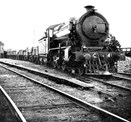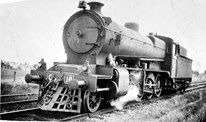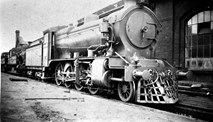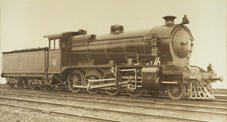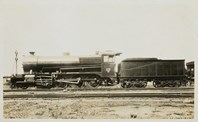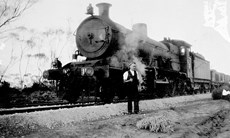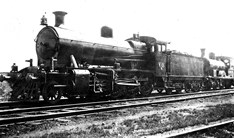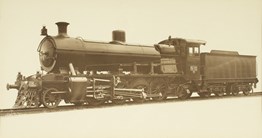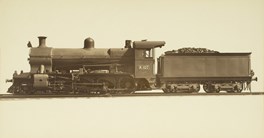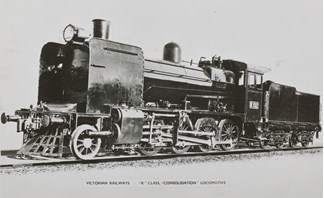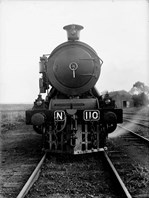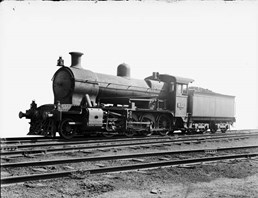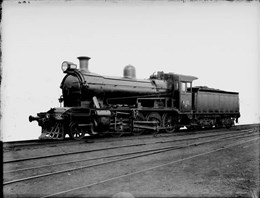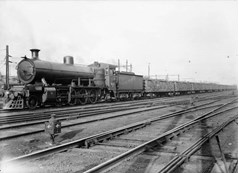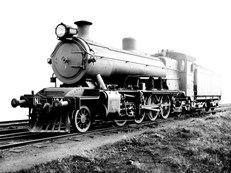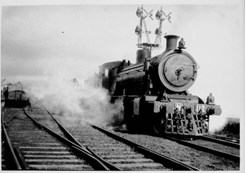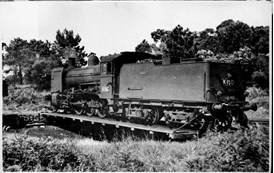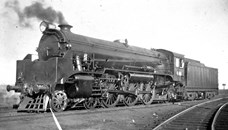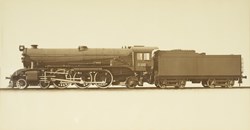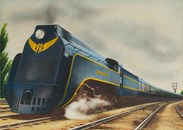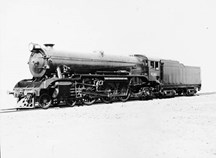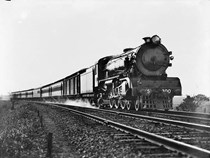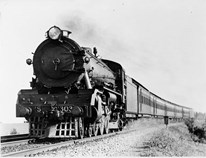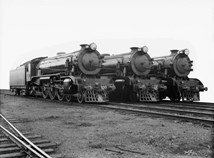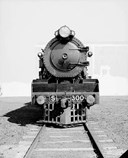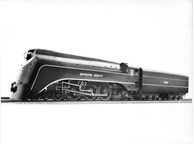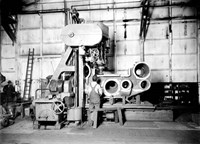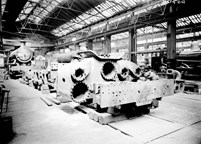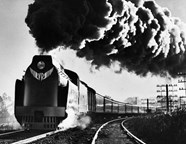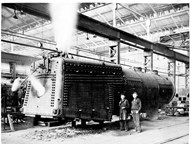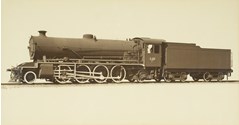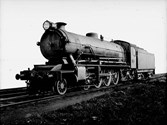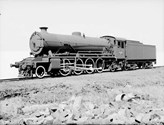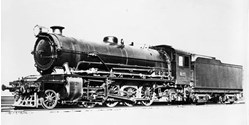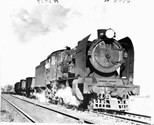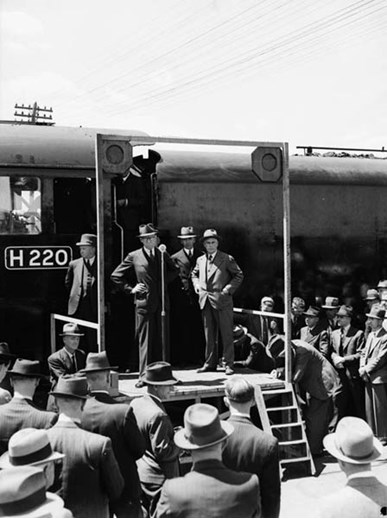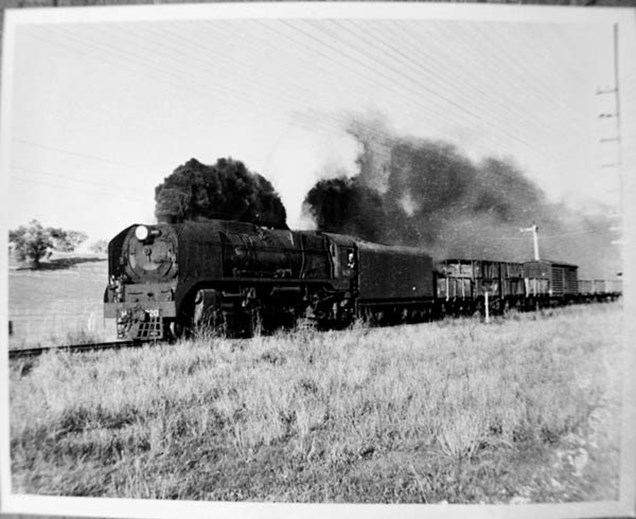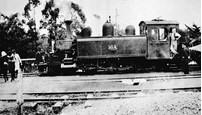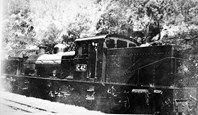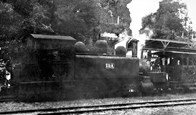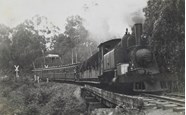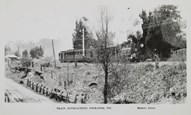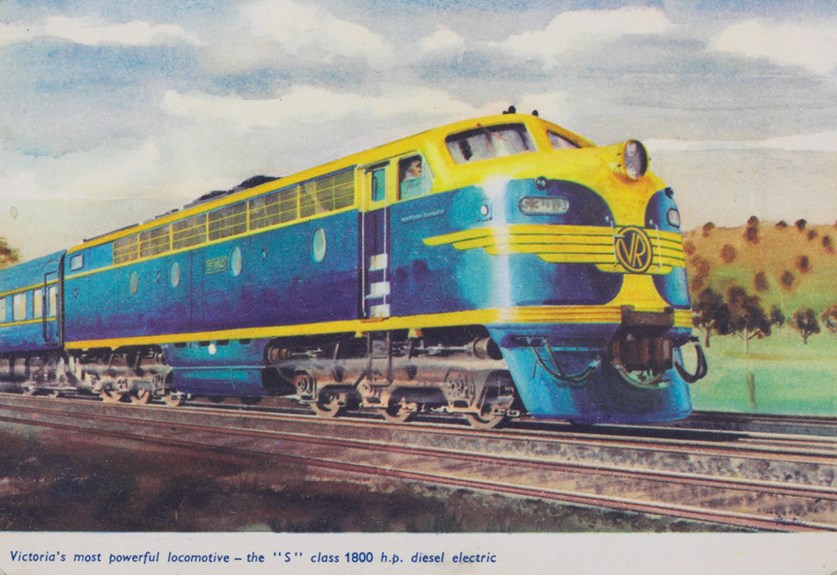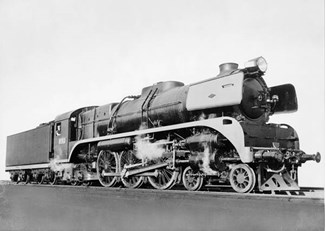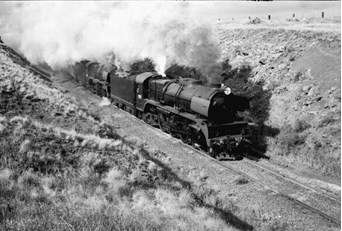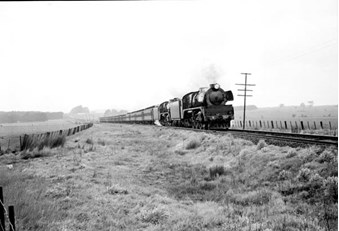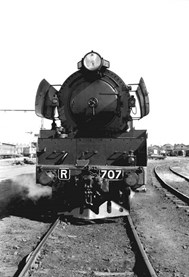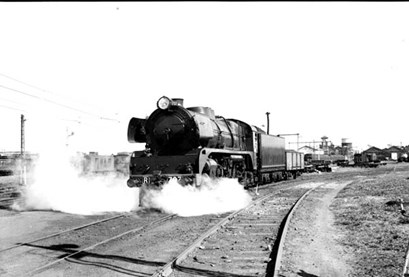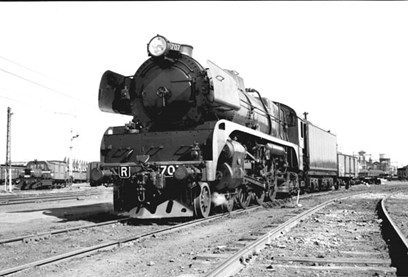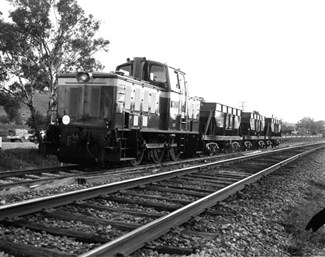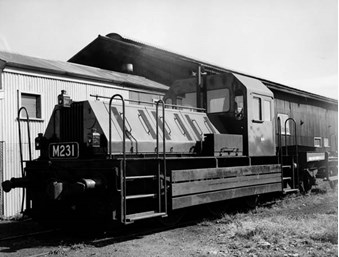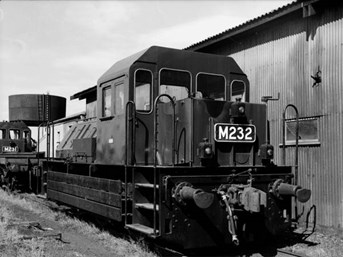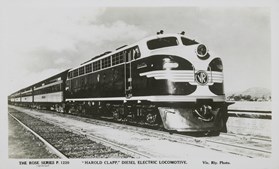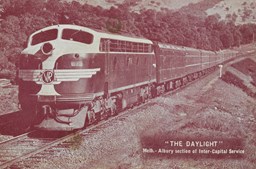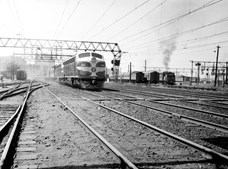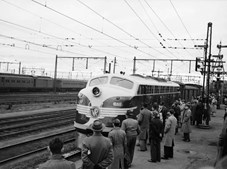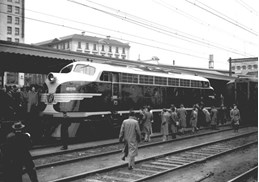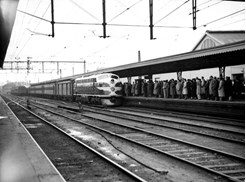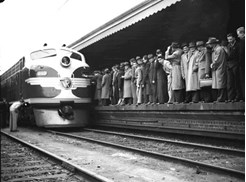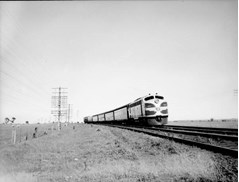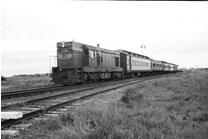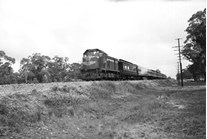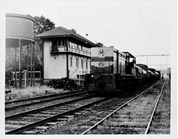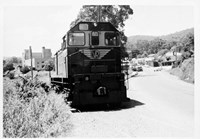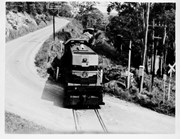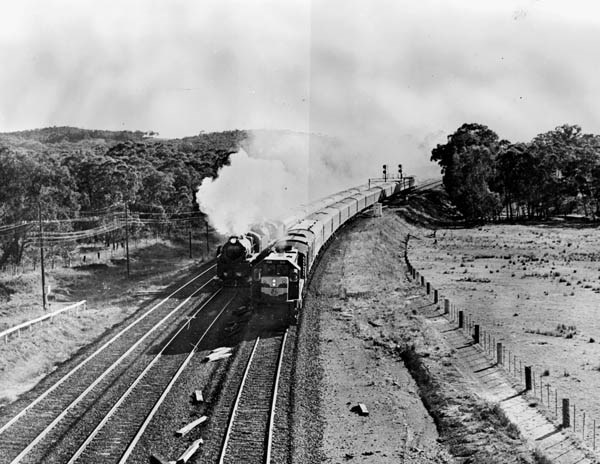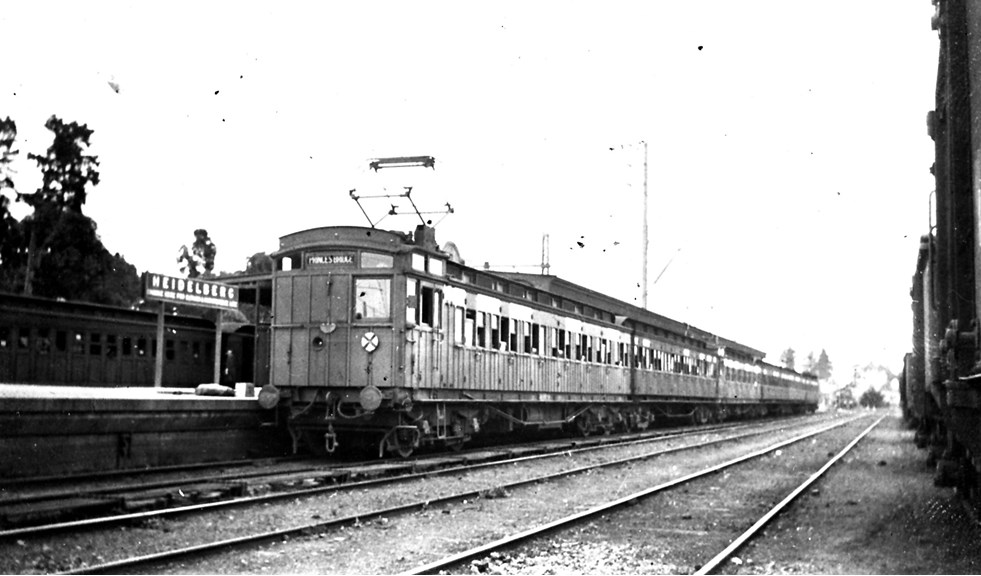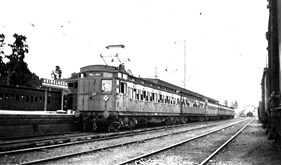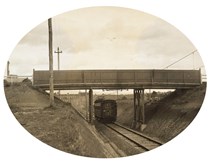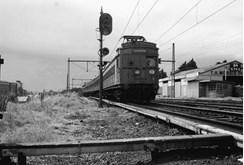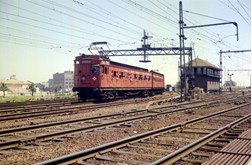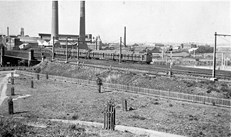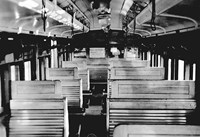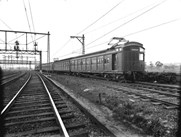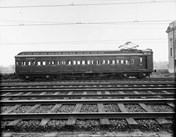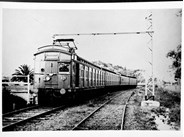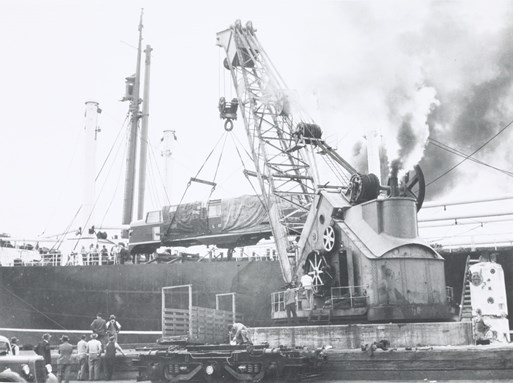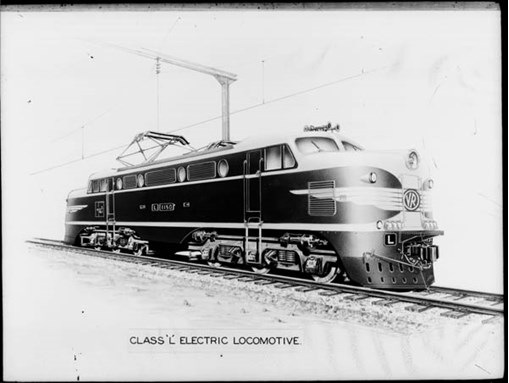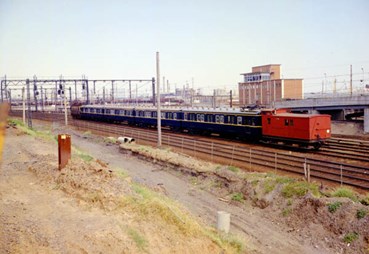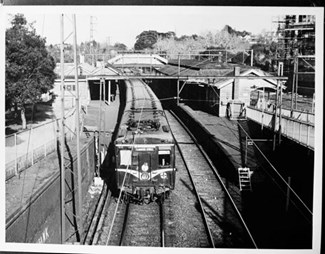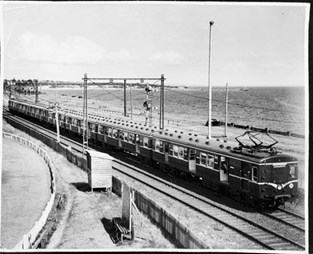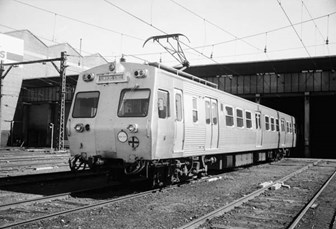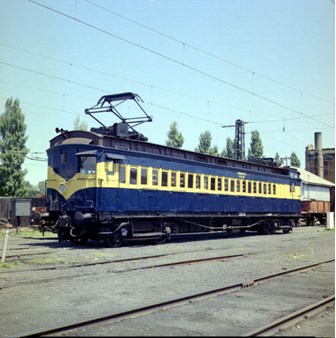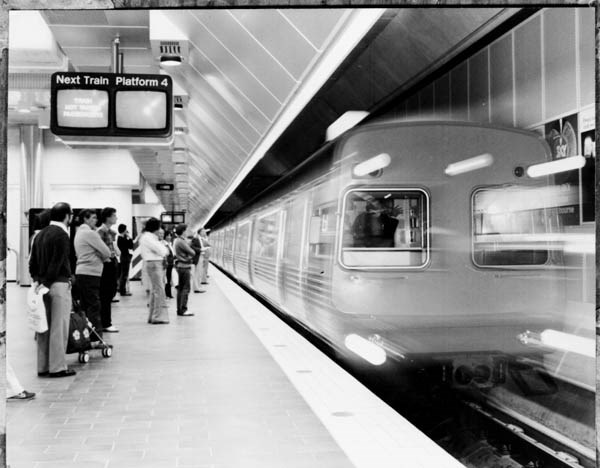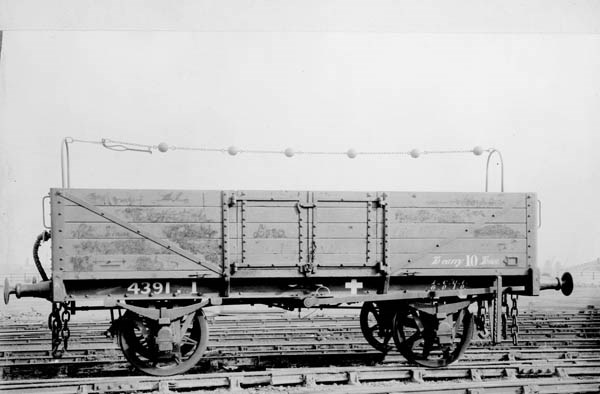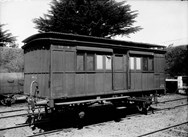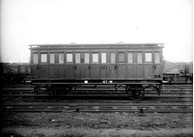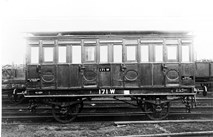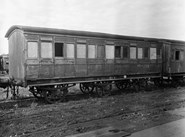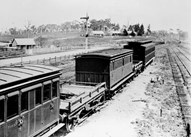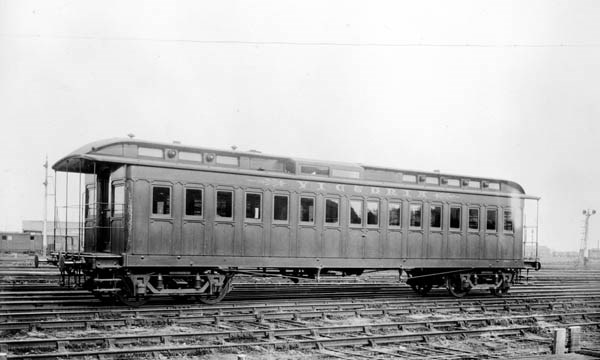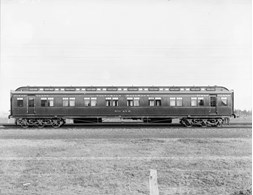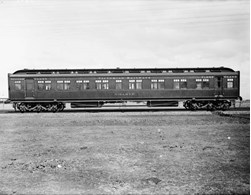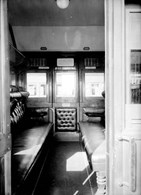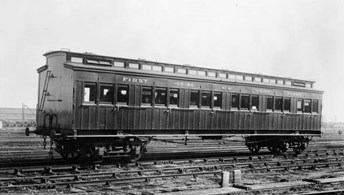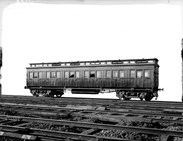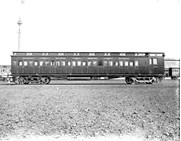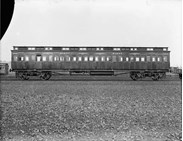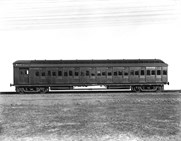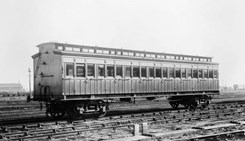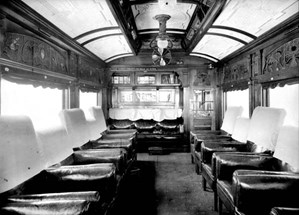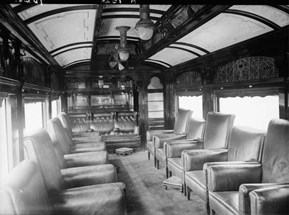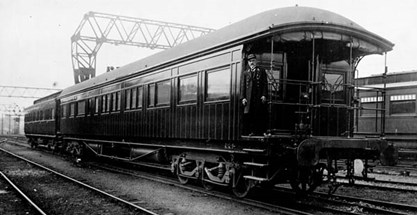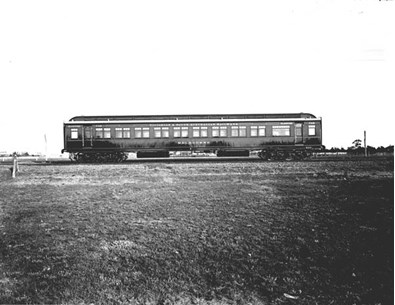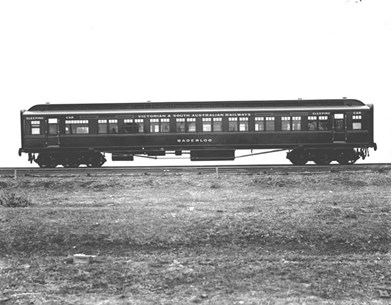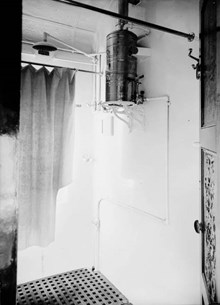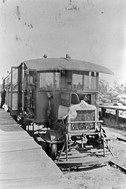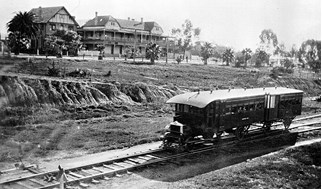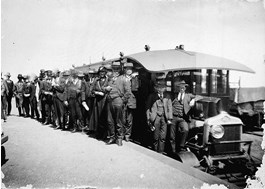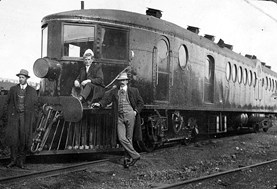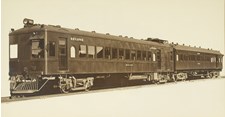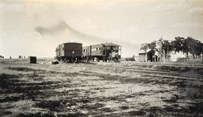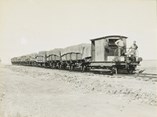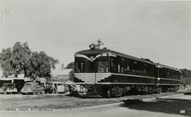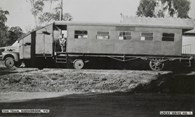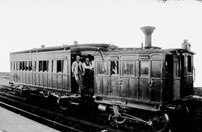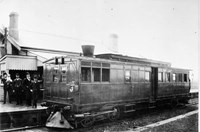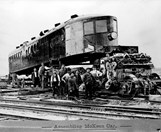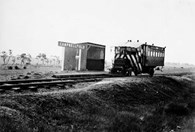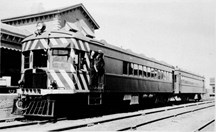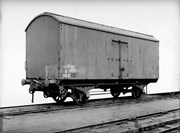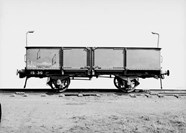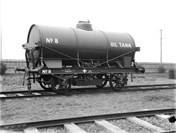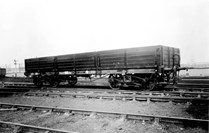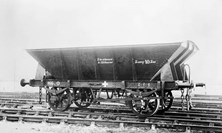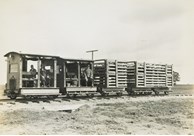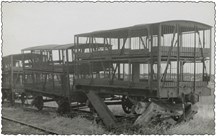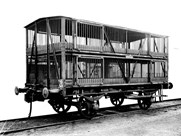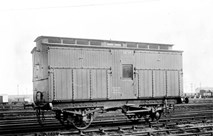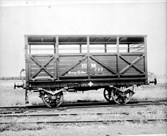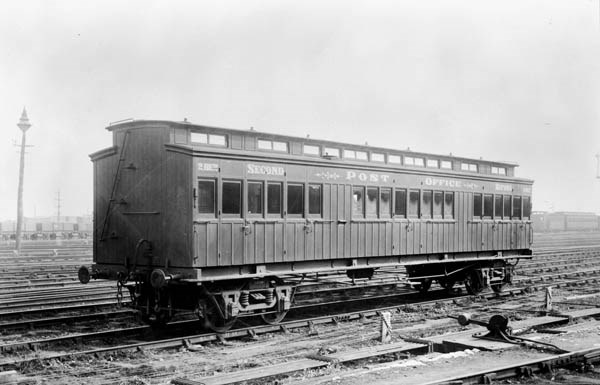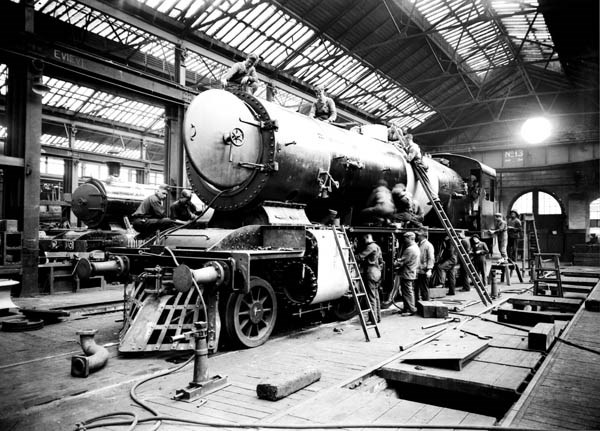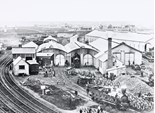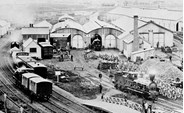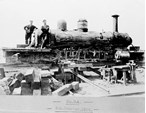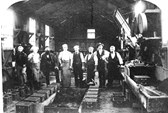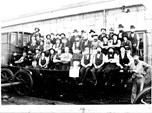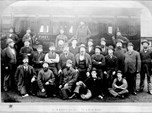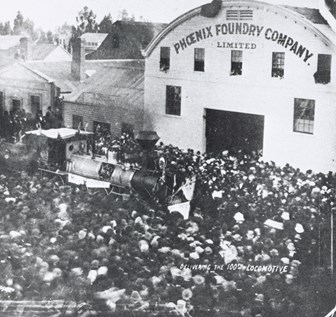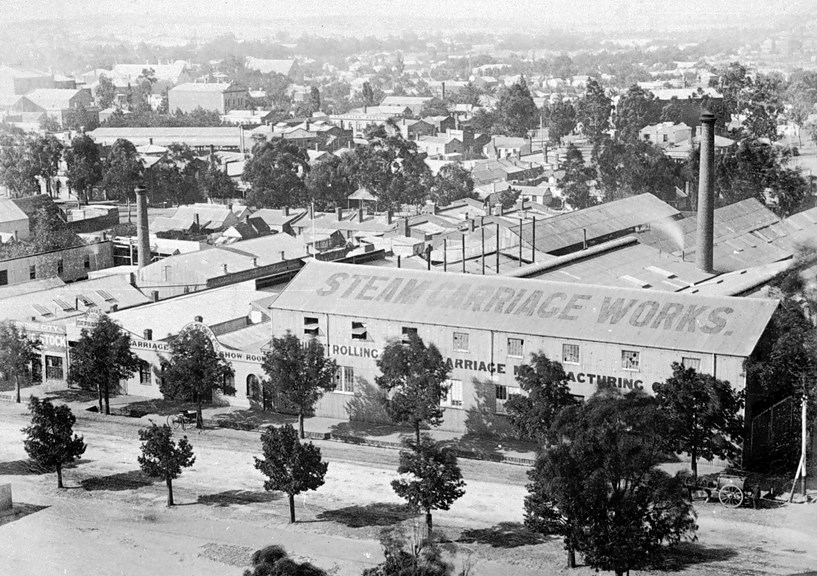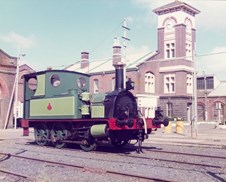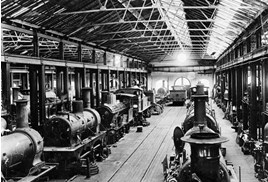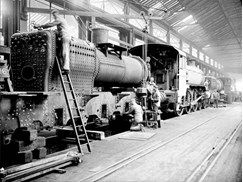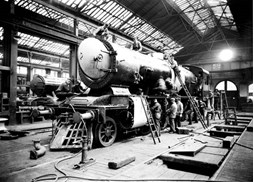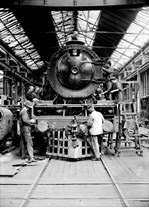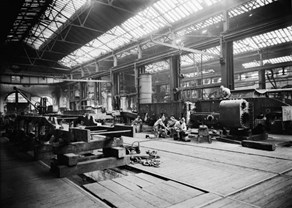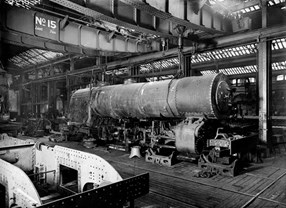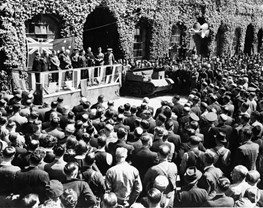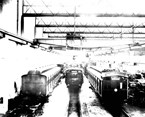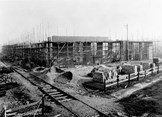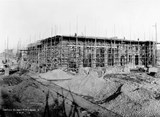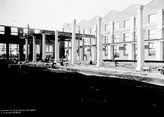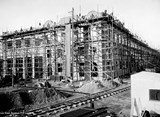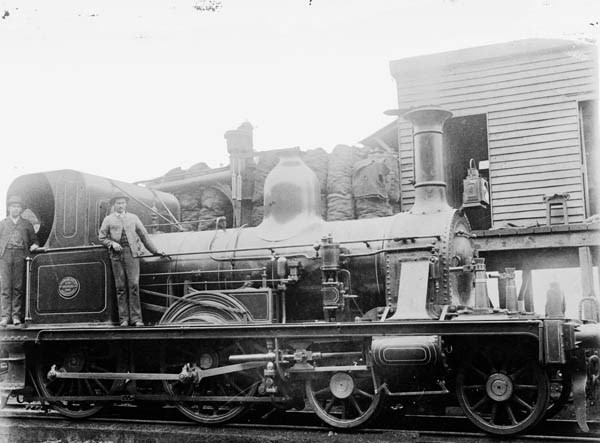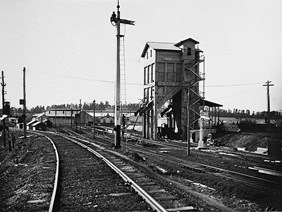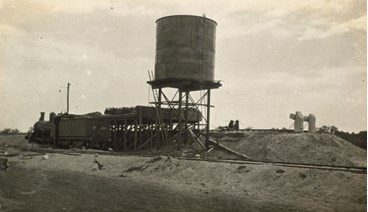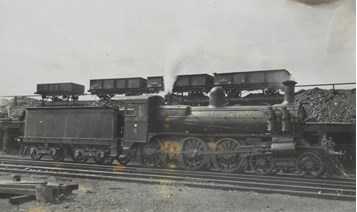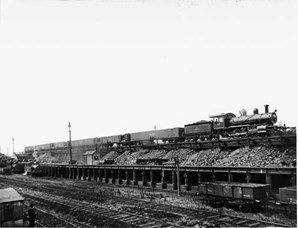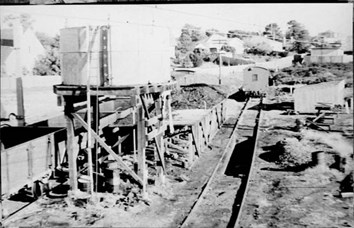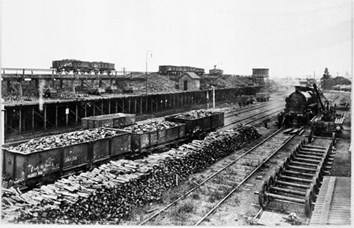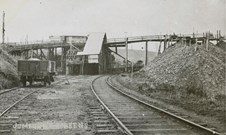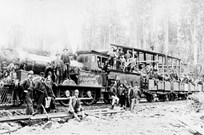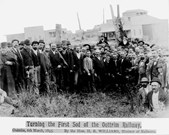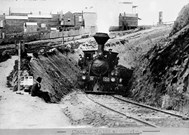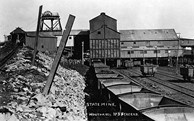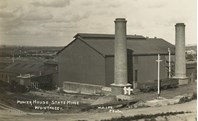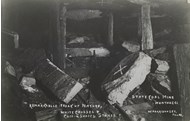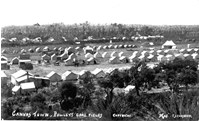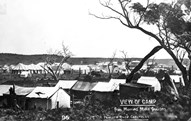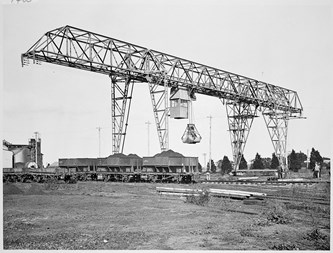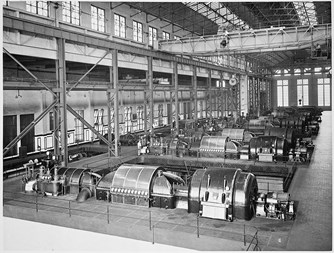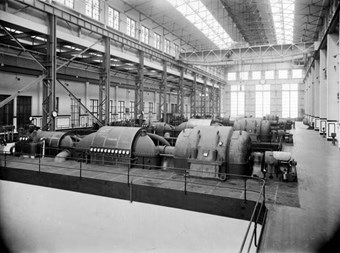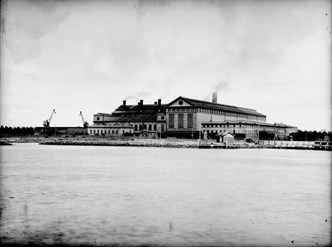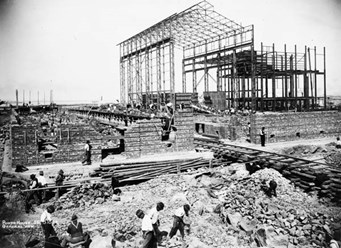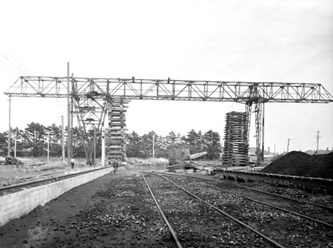Power parade
Locomotives and rolling stock are the essential workhorses of any railway system, and for many they present the most visible public face of the railways. From an initial collection of just 5 steam locomotives and a handful of carriages and goods wagons in 1859, the Victorian Railways' fleet grew to number 528 steam locomotives, 1,150 carriages and 10,000 goods vans and wagons in 1900, with the railways carrying 55 million passengers and 3.4 million tons of freight. After peaking in 1918 with 817 steam locomotives, the VR engine fleet was to undergo a dramatic change in the early 1950s with the introduction of diesel locomotives. Three hundred steam engines were scrapped in just 12 years and the last steam engines retired another 8 years later.
Steam locomotives have long held the fascination of young and old alike. From the sharp pant of the exhaust as a steam engine works up a steep grade, to the gentle whisper of escaping steam as it sits patiently at a platform awaiting departure, the steam locomotive appears to 'breathe' with a life of its own. The first S class diesel locomotives must have been a particularly impressive spectacle to the generation born in the grit and grime of the steam age: roaring past a trackside bystander, resplendent in gleaming blue and gold VR paintwork with the throaty growl of an 1,800 horsepower V-16 engine and a thousand ton load in tow.
Colonial steam power
The first generation of locomotives employed by Victoria's private railway companies and the government railway department were, with one exception, all imported from leading British manufacturers and followed well established British design practise. Somewhat surprisingly, however, when the first public steam train went into service on the Melbourne to Sandridge (Port Melbourne) line on 12 September 1854, it was hauled by a locally built steam engine because engines ordered from England had failed to arrive in time. The locally made engine was not an outstanding success and it would be almost 20 years before another Victorian-built locomotive appeared on the board gauge.
When the Geelong & Melbourne Railway Company and the fledgling Victorian Railways Department ordered the locomotives for Victoria's first country railway services in the late 1850s, both followed conventional British practise by selecting 2-2-2 type engines with a single driving axle for their passenger services and 0-6-0 type engines with six-coupled driving wheels for slower goods trains. It was soon found that the big 'single wheelers' had inadequate traction for the steeper grades on the inland lines over the Great Dividing Range, and so subsequent orders for passenger engines specified a 2-4-0 type design, which together with the 0-6-0 arrangement for goods engines would become the standard Victorian locomotive convention until after 1900.
The first attempt to introduce standard locomotive designs in Victoria was made during the boom years of the late 1880s, when it was realised that the proliferation of earlier makes and models was causing a major operational and maintenance headache. The British engineer Mr E. Jeffreys was commissioned to produce drawings for five standard locomotive designs with assistance from Kitson & Co, of Leeds. The new designs comprised: the 4-4-0 type D class light lines passenger engine; the 0-6-0 type 'New' R class light lines goods engine; the 4-4-0 'New' A class mainline passenger engine; the 0-6-0 Y class mainline goods engine; and the 2-4-2 tank type E class (later EE class) suburban passenger engines. The designs had some commonality in boilers while a number of the other major components, such as cylinders and con-rods, were also partially interchangeable. Orders for significant batches of the new designs were placed with the local manufacturers, Phoenix Foundry Co, of Ballarat, Robison Bros., Campbell & Sloss, of South Melbourne, and David Munro's Melbourne Engineering & Locomotive Works during 1888-91.
Hobsons Bay locos
The Hobsons Bay Company and other suburban railway companies selected primarily small, tender-less engines of the 2-4-0 tank type with four coupled driving wheels for their initial metropolitan services. With a couple of exceptions, all their engines were ordered from the well-known manufacturer Robert Stephenson & Co of Newcastle-upon-Tyne.
In the early 1870s the Melbourne & Hobsons Bay United Company ordered an additional batch of 4-4-0 tank locomotives from the same manufacturer. Two small 0-4-0 tank locomotives were also acquired from the same source in 1857 and 1875 to be used for shunting goods trucks on the pier at Port Melbourne. They became known as the 'pier donkey' engines. In 1878 when the Victorian Railways took over the company, all its locomotives were transferred to become part of the VR fleet, although some were retired or sold off not long afterwards.
George England locos
When the Victorian Railways placed orders for its first five locomotives in 1857 all the larger British manufacturers were too busy to guarantee delivery in the time required, so the engines were ordered from the recently established Hatcham Ironworks of George England & Company in London.
The four 0-6-0 type goods engines and one 2-2-2 type passenger engine where similar to those ordered by the Geelong & Melbourne Railway Company and arrived in Hobsons Bay in May 1858 where they were off-loaded at the Williamstown pier and assembled in workshops built on the foreshore. In 1860, George England & Company supplied a further seven engines to the Victorian Railways of an unconventional 2-4-0 saddle-tank design also intended for passenger services.
Beyer Peacock locos
Beyer, Peacock & Company of Manchester were the second British manufacturer to produce steam locomotives for the Victorian Railways, receiving an order for five 2-2-2 type passenger engines and 0-6-0 type goods engines in early 1859. They were to become the largest overseas manufacturer of locomotives for the Victorian Railways before 1950, producing a total of 79 engines to 14 different designs between 1869 and 1926.
Their solid well-designed engines with clean lines were to prove reliable performers and had a major impact on Victorian Railway locomotive design before 1900.
Phoenix Foundry locos
The Phoenix Foundry Company Ltd of Ballarat was the first Victorian firm to benefit from a change of Government policy in the early 1870s to stimulate Victorian manufacturing through preferential tendering for locomotive and rolling stock contracts. After gaining a contract to build ten 0-6-0 type Q class goods locomotives for the new 'light lines', their first engine was delivered to the Victorian Railways on 27 February 1873.
A steady stream of orders followed over subsequent decades with the company producing a total of 352 steam locomotives for the Victorian Railways from 1873-1904, built to a staggering 38 different designs. At its peak during the late 1880s, the Phoenix Foundry employed over 300 workers and was turning out new engines at the rate of one a week.
Suburban tank locos
After the Victorian Railways took over the suburban railway system from the Melbourne & Hobsons Bay United Railway Company in 1878, two further tank locomotive designs were introduced in an effort to improve services by allowing train sizes to be increased.
The first was a 4-4-0 tank type design based on a pattern engine acquired from Beyer, Peacock & Company of Manchester in 1878, which became the M class, with 32 subsequent examples built at the Phoenix Foundry at Ballarat in 1884-86. The second was a later 2-4-2 tank type which became the E or EE class and was based on a pattern engine supplied by Kitson & Company of Leeds, with 45 similar engine later built at the Phoenix Foundry and another 25 built by the Melbourne Engineering & Locomotive Works of David Munro & Company.
Yankee locos
After extensive criticism of the British-influenced designs used for Victoria's early light lines engines, two small batches of 4-4-0 and 4-6-0 type locomotives were ordered from established American manufacturers in the late 1870s for trial on the light lines. With classic 'Yankee' loco lines, they looked slightly incongruous against other Victorian engines of the period. A further ten locomotives copied from the 4-6-0 American design were built by the Phoenix Foundry in 1883, becoming known as the 'Phoenix Yankees', but despite numerous design innovations and long working lives, neither design was further developed locally.
An American influence again came into play in the late 1890s when two small 2-4-0 tank engines and a large 2-8-0 heavy goods engine were ordered from the Baldwin Locomotive Works of Philadelphia. They included the first two compound engines to work on the Victoria Railways and were used as 'pattern' engines for the NA class 'Puffing Billy' engines that worked the Victorian narrow gauge lines and a class of 15 heavy goods engines built by the Phoenix Foundry in 1901-2.
Williamstown locos
The Williamstown Workshops built three passenger and four goods locomotives for the Victorian Railways to four different designs between 1871 and 1879. The engines were essentially prototypes, built to test a variety of light-weight designs for use on the light branchlines established during the 1870s. The facilities at Williamstown were never sufficient to undertake the manufacture of locomotives on a more extensive scale, and when further engines to the same design were required they were ordered from the Phoenix Foundry at Ballarat.
Setting new standards
The Victorian Railways arrived at the end of the 19th century with a sizeable fleet of 278 'passenger' locomotives and 255 'goods' locomotives, but many of its engines were up to 40 years old and considerably out-of-date. As train sizes had increased, double and triple-heading had become commonplace, substantially adding to running costs.
With the new century came a major rethinking of locomotive design and procurement in the Victorian Railways. Following the construction of the Newport Workshops and the establishment of a Locomotive Design Section, a decision was made to introduce a new series of standard locomotive designs that would be entirely developed by Victorian engineers from the ground up.
The first of the new designs was the Dd class 4-6-0 engine of 1902, the Victorian Railway's first truly mixed traffic engine intended for both passenger and goods work on the light branch lines. The design was so successful that eventually 261 would be built in total, making them the most numerous type of steam locomotive in the State.
Over the next 25 years there emerged from the Victorian Railways drawing office six further standard locomotive designs, to which a total of 500 locomotives were built under the watchful eye of the remarkable engineer Alfred Ernest Smith, first as Chief VR Locomotive Designer and later as Chief Mechanical Engineer. They were the A2 class (1907) and S class (1928) express mainline passenger locomotives, the C class (1918) and X class (1929) heavy mainline goods locomotives and the K class (1922) and N class (1925) mixed light branchline locomotive designs. The final 'standard' VR design to be built in Victoria was the 4-8-4 type H class locomotive 'Heavy Harry', completed in 1941. Although originally intended as a standard class with 3 or 4 engines like the S class, only the one H class locomotive was ever built.
Dd class locos
The 4-6-0 type Dd class was the first of seven standard steam locomotives designed by Victorian Railways engineers in the early decades of the 20th century. Intended as a mixed traffic locomotive primarily for use on the light branchlines, it proved a successful and highly versatile engine with 261 built by the government workshops and private contractors between 1902 and 1920.
Later improvements included the provision of superheaters from 1914 and larger boilers from 1922. When the planned electrification of the Melbourne suburban system was delayed, a modified 4-6-2 tank engine version (known as the DDE class) was developed to haul larger suburban passenger trains, with some 58 built between 1908 and 1913.
A2 class mainline locos
The 4-6-0 type A2 class was the second standard locomotive design developed by the Victoria Railways. Intended for express mainline passenger use, they cut a striking appearance when first introduced in 1907 and soon developed as one of the most popular engines with drivers.
The first 125 built were fitted with conventional slide valves and Stephenson's valve gear, while the final 60 built, from 1915 to 1922, had superheated boilers, improved piston valves and outside Walschaert valve gear, giving them a significantly different appearance.
C class 'Consolidation' locos
The 'Consolidation' 2-8-0 type C class locomotive design was intended as a standard heavy goods engine for mainline work. When the class leader C-1 emerged from Newport Workshops in 1918, it was the heaviest and most powerful locomotive in Australia with a power rating 205% that of the original Dd class. A total of 26 C class engines were built between 1918 and 1926. All had superheated boilers from new and were converted to oil firing in 1946-7.
K and N class branch line locos
The 'Consolidation' 2-8-0 type K class locomotive design was introduced in 1922 to supplement the Dd class engines as a general mixed traffic locomotive for use on light branchlines. The design offered almost 40% more power than the Dd class with only 10% more weight and a similar overall size and maximum axle loading.
Initially ten K class locomotives were built in 1922-23. In 1925, the design was updated as the 2-8-2 type N class engine with wider fireboxes and provision for eventual conversion to standard gauge, although this never occurred. Thirty N class locomotives were built initially, from 1925-28, with an additional 43 entering service in 1949-51. A further 43 K class engines were also built during 1940-46, to cater for increased traffic on branchlines with older turntables that could not accommodate the longer N class locomotives.
S class 'Pacific' locos
The remarkable 4-6-2 type S class express passenger engine, first introduced in 1928, was to become Victoria's premier steam locomotive design. Although only four of the massive 3-cylinder S class engines were built, they were immortalised in the 1930s by the addition of streamlined cowlings and a distinctive 'blue and gold' livery for the new Spirit of Progress Melbourne-Wodonga express service which became the 'flagship' of the Victorian Railways.
X class 'Mikado' locos
The 2-8-2 type X class, first introduced in 1929, was designed as an upgraded version of the C class and was intended for use on heavy mainline goods traffic.
H class loco 'Heavy Harry'
The 4-8-4 type H class locomotive, later affectionately known as 'Heavy Harry', was built by the Newport Workshops entering service in 1941. Although originally intended to haul the heavy Melbourne to Adelaide passenger express, 'Heavy Harry' spent its entire 17-year operating life relegated to working the North-East line to Wodonga after planned upgrades to bridges and tracks on the western line, to carry its colossal 260 ton weight, were never implemented. Its tractive effort of 55,000 lbs (245 kN), it was placed head and shoulders above all other Victorian steam locomotives in pulling power.
Narrow gauge locos
Victoria's four 2-ft 6-in (762 mm) narrow gauge railways were initially worked exclusively by 2-6-2 type tank locomotives. The class leaders of these quaint little workhorses, numbered 1A and 2A, were imported from the Baldwin Locomotive Works in America, with a further 15 examples being built at the Newport Workshops from 1900-15.
In 1926, the NA class locomotives were supplemented by two G class 2-6-0+0-6-2 'Garratt' type steam locomotives built by Beyer Peacock & Company Ltd of Manchester, England, which were the only articulated steam locomotives used on the Victorian Railways.
Enter the diesels
Following the Second World War, the Victorian Railways locomotive fleet was in desperate need of renewal. Traffic volumes had grown significantly, yet for 15 years since the early 1930s depression there had been only limited capital investment in the railways. In 1950, a £80 million railways rehabilitation program called 'Operation Phoenix' was launched, which included orders for 130 additional steam locomotives. Victorian Railways engineers had developed designs for two new standard locomotive classes, but with a backlog of urgently needed maintenance and overhauls it was recognised that Victorian workshops would not have the capacity to manufacture the locomotives without long delays, so orders were instead placed with two leading British manufacturers. They would be last steam locomotives built for the Victorian Railways.
Operation Phoenix also included orders for the first diesel-powered locomotives for Victorian Railways. Ten F class diesel-electric shunting locomotives entered service in 1951, followed by B class diesel-electric mainline locomotives in 1952-3. The latter engines had a dramatic impact on Victorian Railways operations, revolutionising engine power. Unlike steam engines, they required little routine maintenance and could be on-duty literally 24 hours a day. The B class locomotives quickly assumed responsibly for hauling much of Victoria's heavy freight and express passenger traffic.
In 1957-61, the diesel fleet was supplemented by eighteen S class locomotives which assumed responsibility for hauling most express passenger services, including the interstate Adelaide and Sydney trains. They in turn were followed by a large batch of T class diesel-electric locomotives that took over much of the mixed branchline traffic.
The end for steam power came quickly. By the late 1950s the once ubiquitous Dd class and A2 class locomotives were being scrapped at the rate of 15-20 a year, and a decade later 'steam' was relegated to little more than shunting duties and backup engine power for the annual wheat harvest. The last two steam locomotives were withdrawn from regular service in April 1972.
Last of the steam locos
70 4-6-4 type R class express mainline passenger engines entered service in 1951-2 allowing many of the older A2 class engines to be retired, while sixty 2-8-0 type J class engines designed to supplement the K and N class engines on general branchline duties were introduced in 1953-54.
Sadly, due to the early success of diesel locomotives in reducing running costs, many of these fine locomotives were withdrawn without ever undergoing a major overhaul and after completing little more than 200,000 kilometres service, less than a tenth of a steam engine's normal life expectancy.
Diesel shunting locos
Ten 350 h.p. F class diesel-electric shunting locomotives were ordered from the English Electric Company as part of 'Operation Phoenix', entering service in 1951. They were the first diesel-electric locomotives on the Victorian Railways, being used primarily for shunting and pilot duties.
B class diesel locos
26 1,500 h.p. B class diesel-electric mainline locomotives were built by the Clyde Engineering Company of New South Wales to an American design, entering service in 1952-53. The classic design featured a driver's cab at either end, allowing the engines to operate in either direction without the need to be reversed on a turntable.
S class diesel locos
18 S class locomotives of 1,800 h.p., then the most powerful in Australia, were built by the Clyde Engineering Company of New South Wales and introduced in 1957-61. They quickly assumed responsibility for hauling most express passenger services, including the interstate Adelaide and Sydney trains, allowing the famous S class steam locomotives to be withdrawn and cut up for scrap.
T and Y class diesel locos
94 of the T class general purpose locomotives were introduced between 1955 and 1968, making them the most numerous diesel-electric locomotive class on the Victorian Railways system. Designed for use on the light branchlines they quickly took over the work previously done by D2, D3, K, J and N class steam locomotives. They were supplemented by the slightly lower powered Y class locomotives from 1963, which had the distinction of being built on bogies and traction motors recycled from former Tait suburban electric passenger trains.
X and C class diesel locos
Ten 1,220 h.p. (1,640 kW) X class diesel-electric locomotives, introduced in 1975-6, and ten 1,830 h.p. (2,460 kW) C class locomotives, introduced in 1977-8, were built by the Clyde Engineering Co Pty Ltd at Rosewater in South Australia. Both were designed for heavy mainline goods work, with the C class engines being the most powerful locomotives used on the Victoria Railways before the V/Line era.
Electric trains
Although electrification of Melbourne's suburban railway network was first discussed in the 1890s, it was not until 1908 that serious planning for the conversion occurred. An overhead single 1,500-volt wire system was selected with direct-current traction motors. Testing of the first electric trains occurred on the Flemington branchline on October 1918, with passenger services being rolled out across all suburban lines between 1919 and 1923.
Melbourne's earliest electric rolling stock consisted of the ubiquitous red passenger trains, popularly known in later years as 'red rattlers'. Most of these carriages dated back to the pre-electric era with the oldest being the cross-compartment 'swing-door' carriages first built for steam operated suburban services in 1888. With planning for the electrification of Melbourne's suburban network already underway, a new standard type of suburban passenger carriage was introduced in 1909 designed for easier conversion to electric operation. The new design featured a wider body with sliding external doors for improved safety and an interconnecting passage-way between compartments. Later known as the "Tait" carriages, they remained in service until 1984.
From the outset of suburban electric services, the standard electric passenger train was made up of a maximum 7-carriage consist. Smaller trains of four, two and one carriage only were used for off-peak services and operations on lower patronised outer metropolitan lines. The rolling stock all consisted of motor cars (with electric motors, overhead pantograph and guard or driver compartment), trailer cars (without traction motors) and driving trailers (without motors but including separate driver controls).
Between 1921 and 1932, six suburban electric passenger carriages were converted into specialised parcel vans to provide separate fast parcels service throughout the metropolitan network. The fast parcels vans were repainted from 1960 in the standard VR blue with a distinctive wide yellow side band. They were finally withdrawn in the 1980s when the service was replaced by road trucks.
On 21 July 1954, the first non-metropolitan electric passenger service in Australia was inaugurated between Melbourne and Warragul hauled by L class electric locomotives. In addition to passenger services, the primary role of the L class locomotives was hauling heavy briquette trains from Yallourn and Morwell to Melbourne. With the decline of the briquette traffic in the 1980s and the extension of suburban electric passenger services as far as Warrigal in 1987, the once mighty L class locomotives were withdrawn from service and mostly scrapped.
Red swing-door trains
The oldest electric rolling stock used on the Melbourne suburban system were the narrow-bodied red cross-compartment carriages, with outward swinging doors. Originally built between 1888 and 1908 for use on steam-operated suburban trains, these carriages were lengthened and fitted with new steel under-frames during conversion for electric operation in 1917-22. Commonly known as the 'doggies' or 'dog-box carriages' to distinguish them from the latter wide-bodied red carriages, they became the longest serving suburban rolling stock, with the last finally being withdrawn in 1974.
Red 'Tait' trains
With planning for the electrification of Melbourne's suburban network already on the horizon, a new standard type of suburban passenger carriage was introduced in 1909, designed for ease of conversion to electric operation. The new design adopted improvements recommended by Chairman of Commissioners Thomas Tait after an overseas tour in 1907. These included a passage-way connecting compartments and sliding doors, allowing the carriages to be safely built 30 cm wider. Later known as 'Tait' carriages or 'Tait Trains', they remained in service until 1984.
L class electric locos
With the decision to electrify the Gippsland railway between Dandenong and Taralgon in the 1950s, 25 mainline electric locomotives for both goods and passenger operation were ordered from the English Electric Company. With a power rating of 1,790 kW delivered by six large traction motors to 12 driving wheels, the locomotives were capable of hauling a load of 1,100 tonnes at 82 km/hour on the level, or 48 km/hour up a 1-in-110 grade. Classified as the L class, the first was delivered by ship from England in January 1953 and entered service after testing and official trials the following April.
Blue 'Harris' electric trains
Growth in patronage and extensions to the electrified suburban network after the Second World War led to a need for additional electric rolling stock. As part of "Operation Phoenix", 30 new electric passenger train sets were introduced from 1956 to 1959, with an additional 30 sets built from 1961-71. The new carriage design incorporated greater open space, double sliding doors and fully upholstered seating, coinciding with the abolition of separate first-class suburban fares in 1958. Painted in the same deep blue and yellow striped livery as the Victorian Railways leading country trains, the new suburban rolling stock were named "Harris trains" after former Chairman of Commissioners, Norman C. Harris.
Stainless Hitachi electric trains
The first modern stainless steel bodied suburban electric trains in Victoria were the "Hitachi" trains which entered service from 1972. They featured wide convex sided bodies built by Martin & King and the Newport Workshops with a distinctive fluted stainless steel exterior finish and Japanese-designed electric traction gear made by Clyde Engineering Co of New South Wales. They were the first standard suburban trains to be fitted with power-closing doors for improved safety. Fifty "Hitachi" stainless steel train sets were built from 1972-78, allowing many of the older red suburban electric rolling stock to be withdrawn.
Other electric locos
Between 1921 and 1932, six suburban electric passenger carriages were converted into specialised parcel vans to provide separate fast parcels service throughout the metropolitan network. The fast parcels vans were repainted from 1960 in the standard VR blue with a distinctive wide yellow side band. They were finally withdrawn in the 1980s when the service was replaced by road trucks.
Following the successful introduction of suburban electric passenger services, the Newport Workshop built two small batches of electric locomotives for shunting work and suburban goods services, later known as E class locos. The first two, built in 1923, had a steeple cab and primitive, somewhat exposed, driver controls leading to the nickname 'Electric Chairs' amongst drivers. Ten additional units with larger box cabins were introduced during 1928-9. From 1965, the remaining ten E class electric locomotives still in service were painted with a blue and yellow livery to match the standard appearance of all the VR's diesel locomotives.
Modern electric trains
Fifty newer 6-car wide-bodied "Comeng" stainless steel suburban train sets were ordered from Commonwealth Engineering (Victoria) in 1979. They were the first suburban trains to feature full air-conditioning.
Rolling stock
Early rolling stock used on the Victorian Railway consisted primarily of short wheelbase vehicles with either two or three fixed axles. Although all carriages were initially imported, by the 1870s a significant proportion of new additions were being made by local contractors or the Williamstown Workshops.
The introduction of the first saloon type bogie carriages occurred in the 1870s, but it was not until the 1890s that significant numbers of larger corridor type bogie carriages were introduced for country travel with separate passenger compartments. Such carriages offered greatly improved passenger comfort, affording both privacy and free movement throughout the carriage during a journey, and having the first onboard toilet facilities.
The first sleeping carriages in Victoria were luxurious Mann boudoir carriages imported in 1887 for the Melbourne-Adelaide service, with the first dining cars being introduced on the Adelaide and Sydney expresses in the 1920s. In 1937, a further innovation occurred when Australia's first fully air-conditioned all-steel carriages were introduced for the flagship Spirit or Progress service, offering a new standard of comfort for first and second class passengers alike.
Goods rolling stock in the 19th century consisted primarily of smaller open wagons and vans with wooden bodies and two fixed axles. In the initial decades only limited goods vehicles were available with fewer than 1,000 in service by 1870, but as the country network expanded goods traffic grew considerably, necessitating substantial increases to the fleet. By 1900 almost 10,000 goods wagons and vans were in service, including the ubiquitous H class produce vans, I class open wagons and U class louvre vans. Specialised livestock wagons were also provided for carrying sheep, cattle and horses.
It was the narrow gauge lines that pioneered the extensive use of bogie goods wagons and vans in the early 1900s. Other innovations on the broad gauge system in the early 20th century included welded all-steel bodied goods trucks, oil tanker wagons and specialised vehicles for other bulk products such as flour, acids and cement. Although a new style of bulk wheat trucks with self-sealing doors was introduced from the 1940s, it was not until the late 1960s that larger bogie type hopper wagons were used for the annual wheat harvest.
Early fixed-axle carriages
Early fixed-axle carriages used on the Victorian Railways typically featured either two saloons with U-shaped seating or cross compartments without internal communication, with seating typically provided for 32 first-class or 50 second-class passengers per carriage. Such carriages remained the standard for most country and suburban services until the later 1880s.
Bogie saloon carriages
American style bogie saloon carriages with end platforms and a centre aisle were first imported in 1874, with further examples made locally over the following decade.
Bogie corridor carriages
The first corridor bogie carriages with seating in separate compartments off a side passageway did not enter service until the 1890s. Also known as 'vestibule' carriages, these were the first rolling stock to provide for passengers movement between adjoining carriages and amongst the first carriages to provide onboard lavatories facilities for country travellers.
Bogie compartment carriages
Bogie carriages with cross passenger compartments without internal interconnections where first built for the Victorian Railways in the 1880s. Despite the later introduction of improved corridor cars, they remained in production until the early 1900s. They were used for local country services and on the suburban system, where they were later converted to become the red swing-door carriages affectionately known as the 'doggies' or 'dog boxes'.
Parlour and dining carriages
Sleeping carriages
Rail motors
Rail motors consisting of a single self-contained passenger carriage and engine unit were an obvious idea for reducing the cost of operating passenger service on more lightly patronised lines. The first vehicles of this type used on the Victorian Railways were two Rowan steam cars introduced in the 1880s. In 1911, two petrol-powered McKeen rail motors were imported from America. With distinctive streamlined bodies and round porthole style windows they cut a striking appearance, but were under-powered and not technically successful.
Shortly after the First World War, the Newport Workshops began building a series of petrol rail motors based on AEC truck chassis and engine units. Despite primitive open-sided passenger compartments and wooden bench seating they proved a success, with some 20 units in service on country branchlines by the mid 1920s. From 1925, Newport also built a number of improved double-ended rail motors with dual driver controls that avoided the need to turn vehicles for return journeys. They were the first diesel-powered vehicles used on the Victorian railways.
Between 1948 and 1950, new improved English-built Walker diesel rail motors were introduced with three standard sized units having seating for 40, 45 and 94 passengers respectively. Painted in the distinctive 'blue and gold' VR livery, they remained the mainstay of passenger services on many country lines until the late 1970s.
Goods trucks and wagons
Livestock trucks
Guards and parcel vans
Maintenance and manufacture
One of the fundamental elements of any working railway system is the provision of workshops for the maintenance and manufacture of rolling stock and locomotives. The first government railway workshops in Victoria evolved more or less by default from a collection of corrugated iron sheds erected on the foreshore near the pier at Williamstown in 1858, to provide space for assembling imported rolling stock and engines for the first government rail lines. They were later extended in an ad hoc fashion to provide facilities for all heavy maintenance and the manufacture of some carriages and goods trucks and a small number of locomotives.
The second phase of railway development beginning in 1871 brought about a major change in government policy with the conscious decision to stimulate Victorian manufacturing industries by placing orders for new locomotives and rolling stock with local contractors. The Phoenix Foundry Company, at Ballarat, was the major beneficiary of this policy, building 352 steam locomotives for the Victorian Railways between 1873 and 1904. Other private companies in Melbourne, Bendigo and Ballarat gained significant contracts to manufacture carriages, goods trucks and additional suburban locomotives.
With the dramatic expansion of the Victorian Railways network under the 'Octopus Act' era of the 1880s, an urgent need developed for improved workshop facilities and as a result new centralised railway workshops were built at Newport between 1884 and 1888. Equipped with the latest labour-saving machinery, the Newport Workshops were ideally placed to assume responsibility for the manufacture of all locomotives and rolling stock in addition to their previous maintenance role when a further change in Government policy occurred in the early 1900s.
Following the First World War, the facilities at Newport were supplemented by new railway workshops built at Jolimont, Ballarat and Bendigo.
Williamstown Workshops
The Williamstown Workshops were first established in 1858 and operated until the late 1880s, employing about 500 workers at their peak. Seven steam locomotives were built at the Williamstown Workshops between 1872 and 1879 with the first of them, locomotive no. 100, becoming the engine which hauled the Railway Commissioners' train for many years.
Phoenix Foundry
The Phoenix Foundry at Ballarat was originally established in 1856 to manufacture and repair machinery for local goldmines. When mining went through a downturn in the 1870s the firm turned to government contract work, producing its first steam locomotive for the Victorian Railways in 1873. The company went on to build 352 steam locomotives for the Victorian Railways. The foundry closed in 1906 after a change in government policy saw locomotive building transferred to the government-owned Newport Workshops.
Rolling stock builders
Newport Workshops
The first small tank locomotive was built at Newport in 1893. By the end of the steam era sixty years later, some 536 steam locomotives had been produced in addition to hundreds of passenger carriages and thousands of goods trucks. At its peak the Newport Workshops employed over 5,000 people and was the largest industrial complex in the State.
Jolimont Workshops
New workshops opened at Jolimont in 1917 with the electrification of the suburban railway network. The workshops initially converted suburban passenger carriages for electric operation and later maintained electric trains.
Country workshops
A policy of decentralising workshop operations in the early 1900s saw the establishment of additional workshops at Bendigo and North Ballarat in 1913-17. Both facilities concentrated mainly on repairs and maintenance, however, from 1919-22 they built 13 steam locomotives in two batches.
The Moama-Deniliquin Railway was originally built by a private company in 1876. Although it was interconnected with the Victorian Railways system at Echuca, the company owned and maintained its own locomotive and rolling stock fleet with a workshop facility at Deniliquin until its acquisition by the Victorian Railways in 1923.
Fuel and power
Firewood and coke were both used as a fuel for Victoria's earliest railway locomotives, but black coal provided better performance and was adopted as the standard fuel on the Victorian Railways by 1860. Small black coal seams had been discovered in the Gippsland and Otway regions as early as the 1840s, but Victoria was not well endowed with black coal resources and for the next 50 years most coal used by the Victorian Railways was imported from the Maitland (Hunter Valley) and Bulli (Wollongong) coal fields in New South Wales.
Although a number of private mines in South Gippsland produced small quantities of black coal from the 1880s onwards, the coal was generally of poor quality and by 1900 Victoria still remained dependant on New South Wales for three-quarters of all coal consumed. A protracted strike by NSW coal miners in 1909 prompted the Victorian Government to develop a state-owned mine on the Powlett River coalfields in order to provide an assured supply of black coal to the railways and other state-owned industries.
The conversion of the suburban railway network to electric operation during 1918-23 had the effect of considerably reducing the Victorian Railways fuel bill. Although the steam-power generators at the Newport Power Station were still coal-fired, they were considerably more efficient than the hundreds of small steam locomotives they replaced.
During the 1930s a further initiative was taken to find alternative sources of fuel for Victorian Railways steam locomotives. Beginning in 1932, an X class and later an R class locomotive were fitted with Stug equipment for pulverised brown coal firing. Victoria had huge brown coal reserves, but brown coal could not be used as a fuel for conventional locomotive firing because of its high moisture content. Although the experiments were technically successful, it was decided not to proceed with further conversions as the introduction of diesel locomotives was already on the horizon. After the Second World War, 152 steam locomotives were converted by the Victorian Railways to oil firing in an initiative that both reduced running costs and the workload on locomotive crews.
Coal stages
Private coal mines
Over a dozen small privately operated black coal mines were established with government encouragement in South Gippsland in the late 1880s. From 1892 the mines began supplying small quantities of coal to the Victorian Railways, and by 1900 they were providing for one-quarter of Victoria's coal consumption, with the Victorian Railways being their largest single customer. The principal mines were centred around Korumburra, Outtrim and Jumbunna on the South Gippsland line and Coalville south of Moe.
Wonthaggi coal mines
The State Coal Mines at Wonthaggi were established as an emergency measure to provide urgently needed black coal for the Victorian Railways during a protracted strike by New South Wales coal miners. Opening on 22 November 1909 on coal seams that had earlier been proved by a Government drilling program, the mine dispatched its first consignment just 3 days later with the coal being taken to Inverloch by bullock wagons for loading onto ships. A branchline from Nyora on the South Gippsland line was built in 1910 by the time production was in full swing. As further shafts were opened up, production increased from 41,000 tons in 1910 to reach a peak of 662,000 tons in 1930.
Initially the mine was highly profitable but production declined in the 1930s as larger seams were worked out and the mine was hit by industrial strife. Although operations became unprofitable, the Railway Commissioners opted to subsidise the mine in order to provide a guaranteed coal supply and the State Coal Mines remained in operation until 1968 when regular steam locomotives operations were finally phased out.
Newport Power Station
The Newport Power Station was built to provide electric power for the electrification of Melbourne's suburban railway system. Construction commenced in 1913, but was interrupted by the First World War with delays in the delivery of equipment ordered from overseas manufacturers. The first turbo-alternator set at Newport began generating power on 20 June 1918.
Alternating current power was distributed at 20,000 volts and 25 cycles/second to fifteen substantial sub-stations built on the various suburban lines, where power was transformed by rotary converters into the 1,500-volt direct-current supply used by trains. The original 79,000 kilowatt capacity of Newport Power Station was later upgraded with new plant in 1939-43. In 1951, its operations were transferred from the Railways to the State Electricity Commission.
